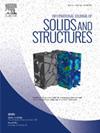3D chemo-mechanical modeling of microstructure evolution and anisotropic deformation in NaxV2(PO4)3 cathode particles for sodium-ion batteries
IF 3.4
3区 工程技术
Q1 MECHANICS
International Journal of Solids and Structures
Pub Date : 2025-06-23
DOI:10.1016/j.ijsolstr.2025.113525
引用次数: 0
Abstract
The cathode material NaV(PO) of sodium-ion batteries displays complicate phase segregation thermodynamics with anisotropic deformation during (de)intercalation. A virtual multiscale modeling chain is established to develop a 3D anisotropic chemo-mechanical phase-field model based on first-principles calculations for NaV(PO). This model accounts for diffusion, phase changes, anisotropic misfit strain, and anisotropic elasticity. The multiwell potential of NaV(PO) is constructed, which captures phase segregation into a sodium-poor phase NaV(PO) and a sodium-rich phase NaV(PO). The elastic properties of NaV(PO) are determined by first-principles for the first time. Furthermore, we address how elastic effects and crystal orientation influence the full 3D microstructure evolution, including phase evolution, interface morphology, and stress evolution in NaV(PO) particles. We find that the quasi-equilibrium single wave propagation along [010] is determined by the anisotropic elasticity tensor. The anisotropic elasticity tensor leads to the striking behavior of warping of the interface. Furthermore, the phase boundary motion is thermodynamically affected by the crystal orientation, which is controlled by minimization of the interface area. It is found that the [010] crystal orientation is mechanically more reliable and recommended for NaV(PO) electrode design. Apart from yielding information about the properties of NaV(PO), the findings of this work may offer an opportunity to achieve improved mechanical stability of the phase separating electrode materials by engineering the crystal orientation.
钠离子电池用NaxV2(PO4)3阴极颗粒微观结构演化及各向异性变形的三维化学力学建模
钠离子电池正极材料NaxV2(PO4)3在(脱)插层过程中表现出复杂的相偏析热力学和各向异性变形。建立虚拟多尺度建模链,建立基于第一性原理计算的NaxV2(PO4)3的三维各向异性化学-力学相场模型。该模型考虑了扩散、相变、各向异性失配应变和各向异性弹性。构建了NaxV2(PO4)3的多井电位,捕获了相分离为贫钠相NaV2(PO4)3和富钠相Na3V2(PO4)3。首次用第一性原理确定了NaV2(PO4)3的弹性性能。此外,我们还研究了弹性效应和晶体取向如何影响NaxV2(PO4)3颗粒的完整三维微观结构演变,包括相演变、界面形态和应力演变。我们发现沿[010]的准平衡单波传播是由各向异性弹性张量决定的。各向异性弹性张量导致了界面翘曲的显著行为。此外,相边界运动受晶体取向的热力学影响,取向由界面面积最小化控制。发现[010]晶体取向在机械上更可靠,推荐用于NaxV2(PO4)3电极设计。除了提供有关NaxV2(PO4)3性质的信息外,这项工作的发现可能为通过设计晶体取向来提高相分离电极材料的机械稳定性提供了机会。
本文章由计算机程序翻译,如有差异,请以英文原文为准。
求助全文
约1分钟内获得全文
求助全文
来源期刊
CiteScore
6.70
自引率
8.30%
发文量
405
审稿时长
70 days
期刊介绍:
The International Journal of Solids and Structures has as its objective the publication and dissemination of original research in Mechanics of Solids and Structures as a field of Applied Science and Engineering. It fosters thus the exchange of ideas among workers in different parts of the world and also among workers who emphasize different aspects of the foundations and applications of the field.
Standing as it does at the cross-roads of Materials Science, Life Sciences, Mathematics, Physics and Engineering Design, the Mechanics of Solids and Structures is experiencing considerable growth as a result of recent technological advances. The Journal, by providing an international medium of communication, is encouraging this growth and is encompassing all aspects of the field from the more classical problems of structural analysis to mechanics of solids continually interacting with other media and including fracture, flow, wave propagation, heat transfer, thermal effects in solids, optimum design methods, model analysis, structural topology and numerical techniques. Interest extends to both inorganic and organic solids and structures.

 求助内容:
求助内容: 应助结果提醒方式:
应助结果提醒方式:


